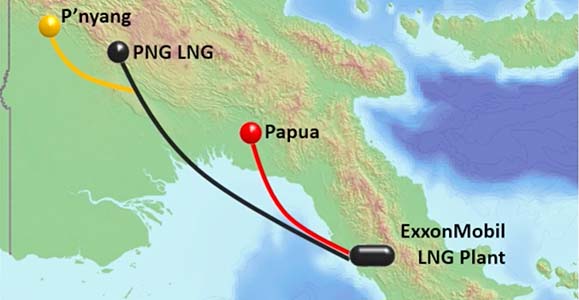‘Heads of agreement’ have been reached for the ExxonMobil-led P’nyang gas project in Papua New Guinea’s Western Province. Business Advantage PNG looks at what this means for the project’s future development.

How P’nyang will connect to PNG’s two larger gas projects, PNG LNG and Papua LNG. Credit: ExxonMobil
Late last month, Papua New Guinea’s Prime Minister James Marape returned from a visit to ExxonMobil’s Texas headquarters, and announced ‘heads of agreement’ has been struck with the oil major for the P’nyang gas project in PNG’s Western Province.
The deal covers the fiscal, regulatory and licensing terms of the project. It grants 63 per cent of ‘total economic benefit’ of the project to the PNG State – a significant increase over previous gas deals and more than was offered before previous negotiations stalled at the start of the year.
The increased benefits is made possible by an increase both in the production levy of three per cent and the State equity (including the commercial purchase) at 32.5 per cent compared to just 19.6 per cent in the PNG LNG project and 22.5 per cent in the Papua LNG project.
‘Ten years from today, the gas up there in the mountains of North Fly may be redundant if we do not engage in a planned harvest of this resource’
While the heads of agreement are, in the words of PNG Chamber of Mines and Petroleum President Anthony Smare, ‘an important first step’ towards a full Gas Agreement and the issuing of a formal 25-year Petroleum Development License for the project, there is still a lot of work to do.
As Prime Minister Marape told Parliament yesterday, issues such as local community benefits must still be addressed.
The project
The P’nyang gas field (covered by Petroleum Retention Licence, or PRL, 3) is located 130 kilometres northwest of Hides, the main PNG LNG field in PNG’s Highlands.
The field contains an estimated 4.4 trillion cubic feet (tcf) of natural gas.
The participants in the P’nyang project are currently ExxonMobil (36.86 per cent), Oil Search (36.86 per cent), Santos (14.3 per cent) and JX Nippon affiliate Merlin Petroleum Company (11.96 per cent).
Assuming a Gas Agreement is finally reached, however, PNG’s national oil company, Kumul Petroleum Holdings Ltd, will acquire a 32.5 per cent interest in the project, with the interests of the other participants reducing proportionally.
‘Not only will this project deliver direct stakeholder benefits but it will continue to drive investment and development across Western Province and the country’
This is 10 per cent more than the 22.5 per cent State interest provided for under PNG’s Oil and Gas Act.
The aim is for P’nyang to share infrastructure with the PNG LNG project, including its 700 km pipeline and the LNG Plant at Caution Bay near Port Moresby, although the government has been determined to treat P’nyang as a standard-alone project for the purposes of licensing and permitting.
Benefits
Progressing the current crop of resources projects, including P’nyang, should be the number one priority for government, according to businesses included in the Business Council of PNG’s September survey of market conditions.
‘Our country desperately needs new gas and mining projects to bring in foreign exchange, create thousands of jobs, create significant business opportunities for PNG SMEs that desperately need them, and generate additional revenue for the State to fund important government services,’ says Anthony Smare.
The potential benefits of a new resources project in Western Province are significant, with the Province’s economy currently heavily dependent on the Ok Tedi copper-gold mine, which is slowly approaching the end of its expected mine-life.
‘Not only will this project deliver direct stakeholder benefits but it will continue to drive investment and development across Western Province and the country,’ Peter Larden, Managing Director of ExxonMobil PNG, told the 2021 Business Advantage Papua New Guinea Investment Conference last month.
He noted the ‘multiplier effect’ of the previous PNG LNG project in laying the foundations for ‘long term partnerships with local business, including landowner companies’.
Likely commencement
While this may be so, it will be several years before the construction of P’nyang commences. Works on the project are being deliberately phased to commence once the Total-led Papua LNG Project in Gulf Province is complete, most likely in 2027.
Nevertheless, it is in the interests of all parties to prevent further delays and to come to final Gas Agreement promptly.
‘The global energy market is moving through a period of transition, away from fossil fuels, and into renewable energy. PNG is facing a risk that if it doesn’t convert the opportunities to develop its gas resources now, it will lose that opportunity forever,’ says Smare.
‘Ten years from today, the gas up there in the mountains of North Fly may be redundant if we do not engage in a planned harvest of this resource,’ Prime Minister Marape told Parliament yesterday.









Speak Your Mind